Beyond Industry 5.0: Leadership 5.0—Driving Future-Ready Organizations
Abstract
1. Introduction
2. Literature Review
2.1. Contemporary Leadership Styles Framing Leadership 5.0
2.2. Framing Leadership 5.0 Within Industry 5.0
2.3. Methodology: Conceptual Model Development
2.3.1. Human-Centric and Emotional Intelligence Approach in a Tech-Driven World
2.3.2. Ethical, Purpose-Driven, and Sustainable Leadership
2.3.3. Inclusive and Collaborative Culture
2.3.4. Future Readiness and Adaptability
2.3.5. Innovation and Experimentation
3. Leadership 5.0 SURVEY Questionnaire Scale Development
3.1. Human-Centric Leadership and Emotional Intelligence Items
- I prioritize the well-being and development of my team members.
- I actively listen to and value input from all members of my team, regardless of their roles.
- I create a safe and supportive environment where team members feel comfortable sharing ideas and concerns.
- I treat all team members fairly and equitably in decision-making processes.
- I inspire my team to find purpose and meaning in their work.
- I am aware of my own emotions and how they affect my leadership decisions.
- I remain calm and composed during challenging situations.
- I demonstrate empathy when addressing the concerns or needs of my team members.
- I handle conflicts within my team constructively and fairly.
- I use emotional intelligence to inspire and motivate my team effectively.
3.2. Ethical, Purpose-Driven, and Sustainable Leadership Items
- I consider the social and environmental impact of my leadership decisions.
- I actively promote ethical practices and integrity in my team and organization.
- I encourage my team to align their work with sustainability goals and values.
- I will communicate the importance of contributing to a sustainable and equitable future.
- I prioritize projects and initiatives that align with ethical and environmental values.
3.3. Inclusive and Collaborative Culture Items
- I create an inclusive culture where diverse perspectives are valued and encouraged.
- I ensure that all team members have equal access to opportunities and resources.
- I encourage cross-functional collaboration and knowledge-sharing within and beyond my team.
- I actively seek the input of underrepresented voices when making decisions.
- I foster trust and unity among team members from divergent backgrounds.
3.4. Future Readiness and Adaptability Items
- I effectively integrate digital tools and technology to improve team productivity and collaboration.
- I encourage my team to develop digital skills and embrace technological advancements.
- I ensure that technology is used to enhance, rather than replace, meaningful human interactions.
- I am adaptable to changes brought about by digital transformation.
- I empower my team to use technology creatively to solve problems and innovate.
3.5. Innovation and Experimentation Items
- I inspire my team to think creatively and explore new ways of solving problems.
- I encourage experimentation and allow team members to take calculated risks.
- I create an environment where innovation is celebrated and rewarded.
- I motivate my team to continuously learn and adapt to emerging challenges.
- I actively implement innovative ideas and practices to improve processes and outcomes.
4. Data Collection Leadership 5.0 Scale Items
Data Analysis: Results of the Pilot Study
- Item 1: 7 7 7 7 7 7 7 7 6 6 5 5 4 4 4 4
- Item 2: 7 7 6 6 5 5 5 5 4 4 2 2 2 2 2 2
- Item 1: 7 7 6.5 6.5 6 6 6 6 5 5 3.5 3.5 3 3 3 3
- Item 2: 6 6 6 6 6 6 6 6 5 5 4 4 4 4 4 4
- Item 3: 7 7 5 5 5 5 5 5 5 5 5 5 4 4 3 3
- Item 4: 7 7 7 7 6 6 5 5 4 4 4 4 4 4 3 3
- Item 5: 7 7 6 6 6 6 5 5 5 5 5 5 5 5 2 2
5. Discussion
6. Conclusions, Limitations, Implications, and Future Research
Author Contributions
Funding
Institutional Review Board Statement
Informed Consent Statement
Data Availability Statement
Acknowledgments
Conflicts of Interest
Appendix A
| Calculation tables for aggregate scores: | |||||||
| Aggregate scores 1 | |||||||
| 94 | 112 | 0.83928571 | 0.84 | 7 | 5.88 | 4.62 | |
| 54 | 112 | 0.48214286 | 0.48 | 7 | 3.36 | ||
| 82 | 112 | 0.73214286 | 0.73 | 7 | 5.11 | ||
| 78 | 112 | 0.69642857 | 0.7 | 7 | 4.9 | ||
| 80 | 112 | 0.71428571 | 0.71 | 7 | 4.97 | ||
| 82 | 112 | 0.73214286 | 0.73 | 7 | 5.11 | ||
| Aggregate scores 2 | |||||||
| 74 | 112 | 0.66071429 | 0.66 | 7 | 4.62 | ||
| 82 | 112 | 0.73214286 | 0.73 | 7 | 5.11 | ||
| 78 | 112 | 0.69642857 | 0.7 | 7 | 4.9 | ||
| 80 | 112 | 0.71428571 | 0.71 | 7 | 4.97 | ||
| 82 | 112 | 0.73214286 | 0.73 | 7 | 5.11 | ||
Appendix B
| Survey questionnaire. |
| 1. Pre-survey questions for organizing data: (A) Organizational level. Required to answer. Single choice. |
| I hold a C-Suite position (CEO, CFO, COO, CTO, etc.). |
| I hold a senior management role (EVP, SVP, VP, etc.). |
| I hold another role at my organization (Head of, Director, Senior Manager, etc.). |
| 2. Pre-survey questions for organizing data: (B) Function in organization. Required to answer. Single choice. |
| I work at a technology company (IT, SW, services, engineering). |
| I work in a technical department at a multipurpose company (R&D, engineering, IT). |
| I work in another function at a multipurpose company. |
| 3. Pre-survey questionnaire for organizing data: (C) Gender. Required to answer. Single choice. |
| I am male. |
| I am female. |
| No selection. |
| 4. Section 1a: Human-centric leadership and emotional intelligence items. Required to answer. Single choice. |
| I fully agree with all the statements. |
| I prioritize the well-being and development of my team members. |
| I actively listen to and value input from all members of my team, regardless of their roles. |
| I create a safe and supportive environment where team members feel comfortable sharing ideas and concerns. |
| I treat all team members fairly and equitably in decision-making processes. |
| I inspire my team to find purpose and meaning in their work. |
| I disagree with all the statements. |
| 5. Section 1b, part 2: Human-centric leadership and emotional intelligence items. Required to answer. Single choice. |
| I fully agree with all the statements. |
| I am aware of my own emotions and how they affect my leadership decisions. |
| I remain calm and composed during challenging situations. |
| I demonstrate empathy when addressing the concerns or needs of my team members. |
| I handle conflicts within my team constructively and fairly. |
| I use emotional intelligence to inspire and motivate my team effectively. |
| I disagree with all the statements. |
| 6. Section 2: Future readiness, digital adaptability and digital mindset. Required to answer. Single choice. |
| I fully agree with all the statements. |
| I effectively integrate digital tools and technology to improve team productivity and collaboration. |
| I encourage my team to develop digital skills and embrace technological advancements. |
| I ensure that technology is used to enhance, rather than replace, meaningful human interactions. |
| I am adaptable to changes brought about by digital transformation. |
| I empower my team to use technology creatively to solve problems and innovate. |
| I disagree with all the statements. |
| 7. Section 3: Sustainability and ethical leadership. Required to answer. Single choice. |
| I fully agree with all the statements. |
| I consider the social and environmental impact of my leadership decisions. |
| I actively promote ethical practices and integrity in my team and organization. |
| I encourage my team to align their work with sustainability goals and values. |
| I communicate the importance of contributing to a sustainable and equitable future. |
| I prioritize projects and initiatives that align with ethical and environmental values. |
| I disagree with all the statements. |
| 8. Section 4: Inclusivity and collaboration. Required to answer. Single choice. |
| I fully agree with all the statements. |
| I create an inclusive culture where diverse perspectives are valued and encouraged. |
| I ensure that all team members have equal access to opportunities and resources. |
| I encourage cross-functional collaboration and knowledge-sharing within and beyond my team. |
| I actively seek the input of underrepresented voices when making decisions. |
| I foster trust and unity among team members from different backgrounds. |
| I disagree with all the statements. |
| 9. Section 5: Innovation-driven mindset. Required to answer. Single choice. |
| I fully agree with all the statements. |
| I inspire my team to think creatively and explore new ways of solving problems. |
| I encourage experimentation and allow team members to take calculated risks. |
| I create an environment where innovation is celebrated and rewarded. |
| I motivate my team to continuously learn and adapt to emerging challenges. |
| I actively implement innovative ideas and practices to improve processes and outcomes. |
| I disagree with all the statements. |
Appendix C
| Cronbach’s Alpha |
| Datasets for Cronbach’s Alpha |
 |
| Step 1: Calculate item variances. |
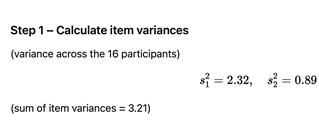 |
| Step 2: Calculate score per person. |
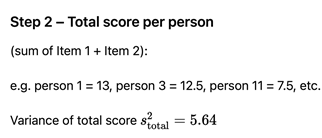 |
| Step 3: Use Cronbach’s Alpha. |
 |
| The analysis returns an overall Cronbach’s Alpha value of 0.948. |
References
- Alban-Metcalfe, J., & Alimo-Metcalfe, B. (2007). Development of a private sector version of the (Engaging) Transformational Leadership Questionnaire. Leadership & Organization Development Journal, 28(2), 104–121. [Google Scholar] [CrossRef]
- Alshaibani, E., Bakir, A., & Al-Atwi, A. (2025). The impact of leadership behaviors on organizational innovative performance and learning in AI-driven Industry 5.0 environments. Development and Learning in Organizations: An International Journal, 39(3), 18–21. [Google Scholar] [CrossRef]
- Antonakis, J., Avolio, B. J., & Sivasubramaniam, N. (2003). Context and leadership: An examination of the nine-factor full-range leadership theory using the Multifactor Leadership Questionnaire. The Leadership Quarterly, 14(3), 261–295. [Google Scholar] [CrossRef]
- Avolio, B. J., & Kahai, S. S. (2003). Adding the “E” to E-leadership: How it may impact your leadership. Organizational Dynamics, 31(4), 325–338. [Google Scholar] [CrossRef]
- Bakir, A., & Dahlan, M. (2023). Higher education leadership and curricular design in Industry 5.0 environment: A cursory glance. Development and Learning in Organizations: An International Journal, 37(3), 15–17. [Google Scholar] [CrossRef]
- Balcerzyk, D., & Czainska, K. (2024). Trust in artificial intelligence and the 5.0 leadership. In Digital synergy (pp. 94–100). CRC Press. [Google Scholar]
- Bansal, P., & Song, H. C. (2017). Similar but not the same: Differentiating corporate sustainability from corporate responsibility. Academy of Management Annals, 11(1), 105–149. [Google Scholar] [CrossRef]
- Barata, J., & Kayser, I. (2023). Industry 5.0–past, present, and near future. Procedia Computer Science, 219, 778–788. [Google Scholar] [CrossRef]
- Basham, L. M. (2012). Transformational leadership characteristics necessary for today’s leaders in higher education. Journal of International Education Research, 8(4), 343. [Google Scholar]
- Bos-Nehles, A., Renkema, M., & Janssen, M. (2017). HRM and innovative work behaviour: A systematic literature review. Personnel Review, 46(7), 1228–1253. [Google Scholar] [CrossRef]
- Breque, M., De Nul, L., & Petridis, A. (2021). Industry 5.0: Towards a sustainable, human-centric, and resilient European industry (No. KI-BD-20-021-EN-N). Directorate General for Research and Innovation (DG RTD) of the European Commission.
- Brown, M. E., Treviño, L. K., & Harrison, D. A. (2005). Ethical leadership: A social learning perspective for construct development and testing. Organizational Behavior and Human Decision Processes, 97(2), 117–134. [Google Scholar] [CrossRef]
- Carroll, A. B. (1991). The pyramid of corporate social responsibility: Toward the moral management of organizational stakeholders. Business Horizons, 34(4), 39–48. [Google Scholar] [CrossRef]
- Colgate, M. (2025). The importance and application of a coaching leadership style in businesses. Businesses, 5(3), 32. [Google Scholar] [CrossRef]
- Cox, T. H., & Blake, S. (1991). Managing cultural diversity: Implications for organizational competitiveness. Academy of Management Perspectives, 5(3), 45–56. [Google Scholar] [CrossRef]
- Damanpour, F., & Schneider, M. (2006). Phases of the adoption of innovation in organizations: Effects of environment, organization, and top managers. British Journal of Management, 17(3), 215–236. [Google Scholar] [CrossRef]
- Davies, K. A., Lane, A. M., Devonport, T. J., & Scott, J. A. (2010). Validity and reliability of a brief emotional intelligence scale (BEIS-10). Journal of Individual Differences, 31(4). [Google Scholar] [CrossRef]
- Demir, K. A., Döven, G., & Sezen, B. (2019). Industry 5.0 and human-robot co-working. Procedia Computer Science, 158, 688–695. [Google Scholar] [CrossRef]
- Edmondson, A. (1999). Psychological safety and learning behavior in work teams. Administrative Science Quarterly, 44(2), 350–383. [Google Scholar] [CrossRef]
- George, J. M. (2007). 9 Creativity in organizations. Academy of Management Annals, 1(1), 439–477. [Google Scholar] [CrossRef]
- Goleman, D. (1998). The emotional intelligence of leaders. Leader to Leader, 1998(10), 20–26. [Google Scholar] [CrossRef]
- Hendrikz, K., & Engelbrecht, A. S. (2019). The principled leadership scale: An integration of value-based leadership. SA Journal of Industrial Psychology, 45(1), 1–10. [Google Scholar] [CrossRef]
- Holroyd, C. (2022). Technological innovation and building a ‘super smart’ society: Japan’s vision of society 5.0. Journal of Asian Public Policy, 15(1), 18–31. [Google Scholar] [CrossRef]
- House, R. J., Hanges, P. J., Javidan, M., Dorfman, P. W., & Gupta, V. (Eds.). (2004). Culture, leadership, and organizations: The GLOBE study of 62 societies. Sage Publications. [Google Scholar]
- Javaid, M., Haleem, A., Singh, R. P., & Suman, R. (2021). Substantial capabilities of robotics in enhancing industry 4.0 implementation. Cognitive Robotics, 1, 58–75. [Google Scholar] [CrossRef]
- Jiang, T., & Ali, D. (2024). The impact of leadership styles on employee relations performance. International Journal of Social Sciences and Public Administration, 3(3), 120–127. [Google Scholar] [CrossRef]
- Kane, G. C., Palmer, D., Phillips, A. N., Kiron, D., & Buckley, N. (2015, July 14). Strategy, not technology, drives digital transformation. MIT Sloan Management Review. [Google Scholar]
- Konno, N., & Schillaci, C. E. (2021). Intellectual capital in Society 5.0 by the lens of the knowledge creation theory. Journal of Intellectual Capital, 22(3), 478–505. [Google Scholar] [CrossRef]
- Murari, K., & Gupta, K. S. (2012). Impact of servant leadership on employee empowerment. Journal of Strategic Human Resource Management, 1(1), 28. [Google Scholar]
- Müller, J. (2020). Enabling technologies for Industry 5.0: Results of a workshop with Europe’s technology leaders. Directorate-General for Research and Innovation. [Google Scholar]
- Mwita, M. M., & Joanthan, J. (2019). Digital leadership for digital transformation. Electronic Scientific Journal, 10(4), 2082–2677. [Google Scholar]
- Nahavandi, S. (2019). Industry 5.0—A human-centric solution. Sustainability, 11(16), 4371. [Google Scholar] [CrossRef]
- Northouse, P. G. (2023). Introduction to leadership: Concepts and practice. Sage Publications. [Google Scholar]
- Nunnally, J. C., & Bernstein, I. H. (1994). Psychometric theory (3rd ed.). McGraw-Hill. [Google Scholar]
- Page, M. J., McKenzie, J. E., Bossuyt, P. M., Boutron, I., Hoffmann, T. C., Mulrow, C. D., & Moher, D. (2021). The PRISMA 2020 statement: An updated guideline for reporting systematic reviews. BMJ, 372, n71. [Google Scholar] [CrossRef]
- Podsakoff, P. M., MacKenzie, S. B., Moorman, R. H., & Fetter, R. (1990). Transformational leader behaviors and their effects on followers’ trust in leader, satisfaction, and organizational citizenship behaviors. The Leadership Quarterly, 1(2), 107–142. [Google Scholar] [CrossRef]
- Posner, B. Z., & Kouzes, J. M. (1988). Development and validation of the leadership practices inventory. Educational and Psychological Measurement, 48(2), 483–496. [Google Scholar] [CrossRef]
- Salvetti, F., & Bertagni, B. (2020). Leadership 5.0: An agile mindset for a digital future. International Journal of Advanced Corporate Learning, 13(2), 57. [Google Scholar] [CrossRef]
- Sariişik, G., & Demir, S. (2025). Industry 5.0: A Human-centric paradigm for sustainable and resilient industrial transformation. Journal of Social Perspective Studies, 2(2), 50–66. [Google Scholar]
- Schnell, P., Haag, P., & Jünger, H. C. (2022). Implementation of digital technologies in construction companies: Establishing a holistic process which addresses current barriers. Businesses, 3(1), 1–18. [Google Scholar] [CrossRef]
- Serrano, C. G., & Mosquera-Bolaños, J. A. (2022). Leadership 5.0. a new approach in higher education. IEEE Revista Iberoamericana de Tecnologias del Aprendizaje, 17(4), 393–400. [Google Scholar] [CrossRef]
- Shore, L. M., Cleveland, J. N., & Sanchez, D. (2018). Inclusive workplaces: A review and model. Human Resource Management Review, 28(2), 176–189. [Google Scholar] [CrossRef]
- Spears, L. C. (2010). Character and servant leadership: Ten characteristics of effective, caring leaders. The Journal of Virtues & Leadership, 1(1), 25–30. [Google Scholar]
- Sun, X., & Song, Y. (2025). Unlocking the Synergy: Increasing productivity through Human-AI collaboration in the Industry 5.0 Era. Computers & Industrial Engineering, 200, 110657. [Google Scholar]
- Tavakol, M., & Dennick, R. (2011). Making sense of Cronbach’s alpha. International Journal of Medical Education, 2, 53. [Google Scholar] [CrossRef]
- Thomas, A., Chawla, Y., Varma, A., & Szleter, P. (2023). The role of business leaders in Industry 5.0. In The International Research & Innovation Forum (pp. 629–640). Springer International Publishing. [Google Scholar]
- Van Dick, R., Lemoine, J. E., Steffens, N. K., Kerschreiter, R., Akfirat, S. A., Avanzi, L., Dumont, K., Epitropaki, O., Fransen, K., Giessner, S., González, R., Kark, R., Lipponen, J., Markovits, Y., Monzani, L., Orosz, G., Pandey, D., Roland-Lévy, C., Schuh, S., & Haslam, S. A. (2018). Identity leadership going global: Validation of the identity leadership inventory across 20 countries. Journal of Occupational and Organizational Psychology, 91(4), 697–728. [Google Scholar] [CrossRef]
- Van Dierendonck, D. (2011). Servant leadership: A review and synthesis. Journal of Management, 37(4), 1228–1261. [Google Scholar] [CrossRef]
- Vogel-Heuser, B., & Hess, D. (2016). Guest editorial Industry 4.0–prerequisites and visions. IEEE Transactions on automation Science and Engineering, 13(2), 411–413. [Google Scholar] [CrossRef]
- Wahlster, W. (2014, February 24–27). Multiadaptive interfaces to cyber-physical environments. Proceedings of the 19th International Conference on Intelligent User Interfaces (pp. 1–2), Haifa, Israel. [Google Scholar]
- Warner-Søderholm, G. (2013). Beyond a literature review of hall’s context dimension: Scale development, validation & empirical findings within a norwegian study. International Journal of Business and Management, 8, 2. [Google Scholar] [CrossRef]
- Warner-Søderholm, G., Čepėnas, S., Minelgaite, I., & Akstinaitė, V. (2024). Sustainability-oriented leader, please! Effects of industry on followers’ preferences. Administrative Sciences, 14(3), 46. [Google Scholar] [CrossRef]
- Weill, P., & Ross, J. W. (2009). IT savvy: What top executives must know to go from pain to gain. Harvard Business Press. [Google Scholar]
- Weill, P., & Woerner, S. L. (2018). Is your company ready for a digital future? MIT Sloan Management Review, 59(2), 21–25. [Google Scholar]
- Whitehead, J., Mohamed Hashim, M. A., Tlemsani, I., & Majid Gilani, S. A. (2025). Strategic Leadership 5.0: Reality or illusion? Journal of the Knowledge Economy, 1–29. [Google Scholar] [CrossRef]
- Xu, L. D., Xu, E. L., & Li, L. (2018). Industry 4.0: State of the art and future trends. International Journal of Production Research, 56(8), 2941–2962. [Google Scholar] [CrossRef]
- Xu, X., Lu, Y., Vogel-Heuser, B., & Wang, L. (2021). Industry 4.0 and Industry 5.0—Inception, conception, and perception. Journal of Manufacturing Systems, 61, 530–535. [Google Scholar] [CrossRef]
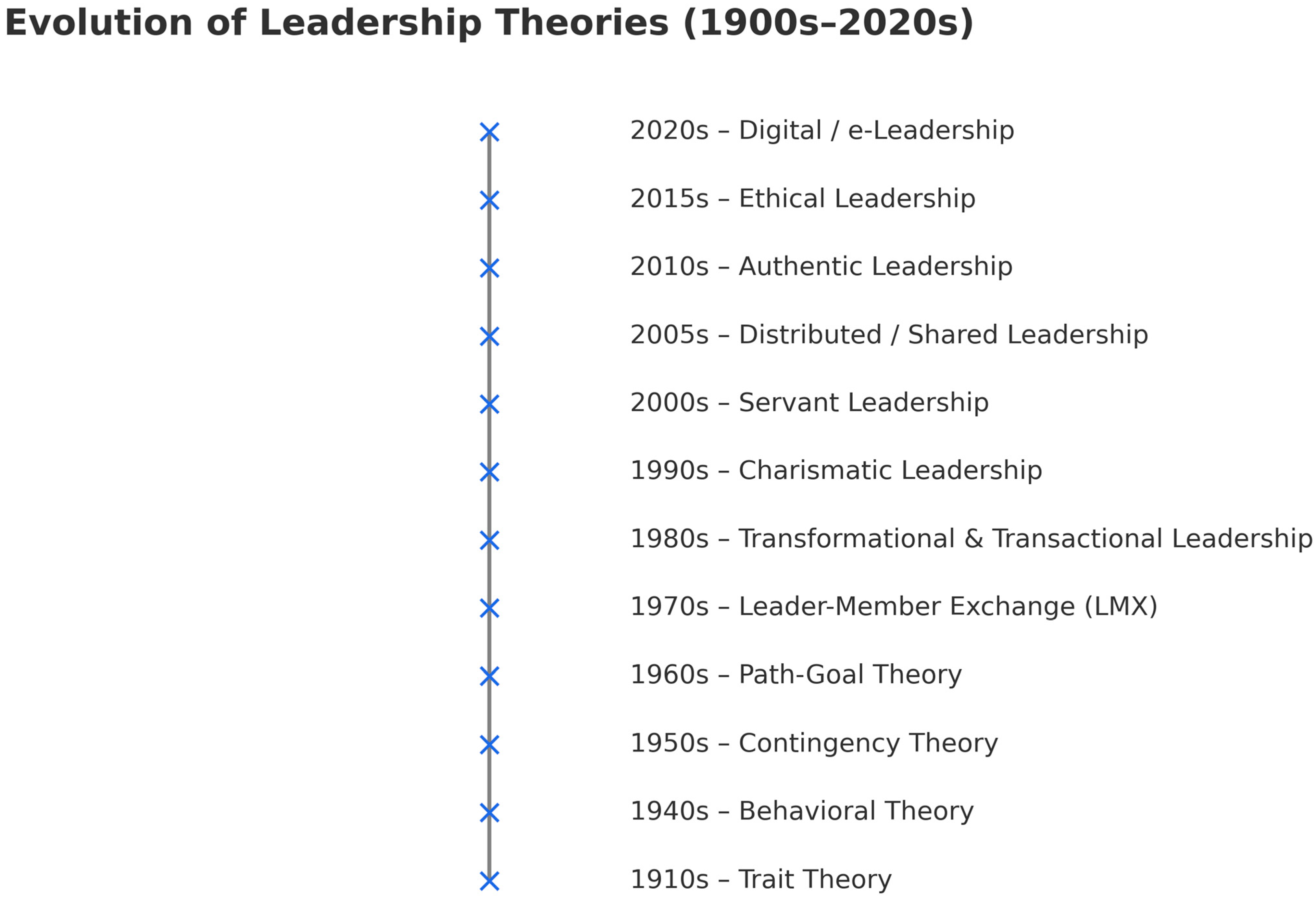
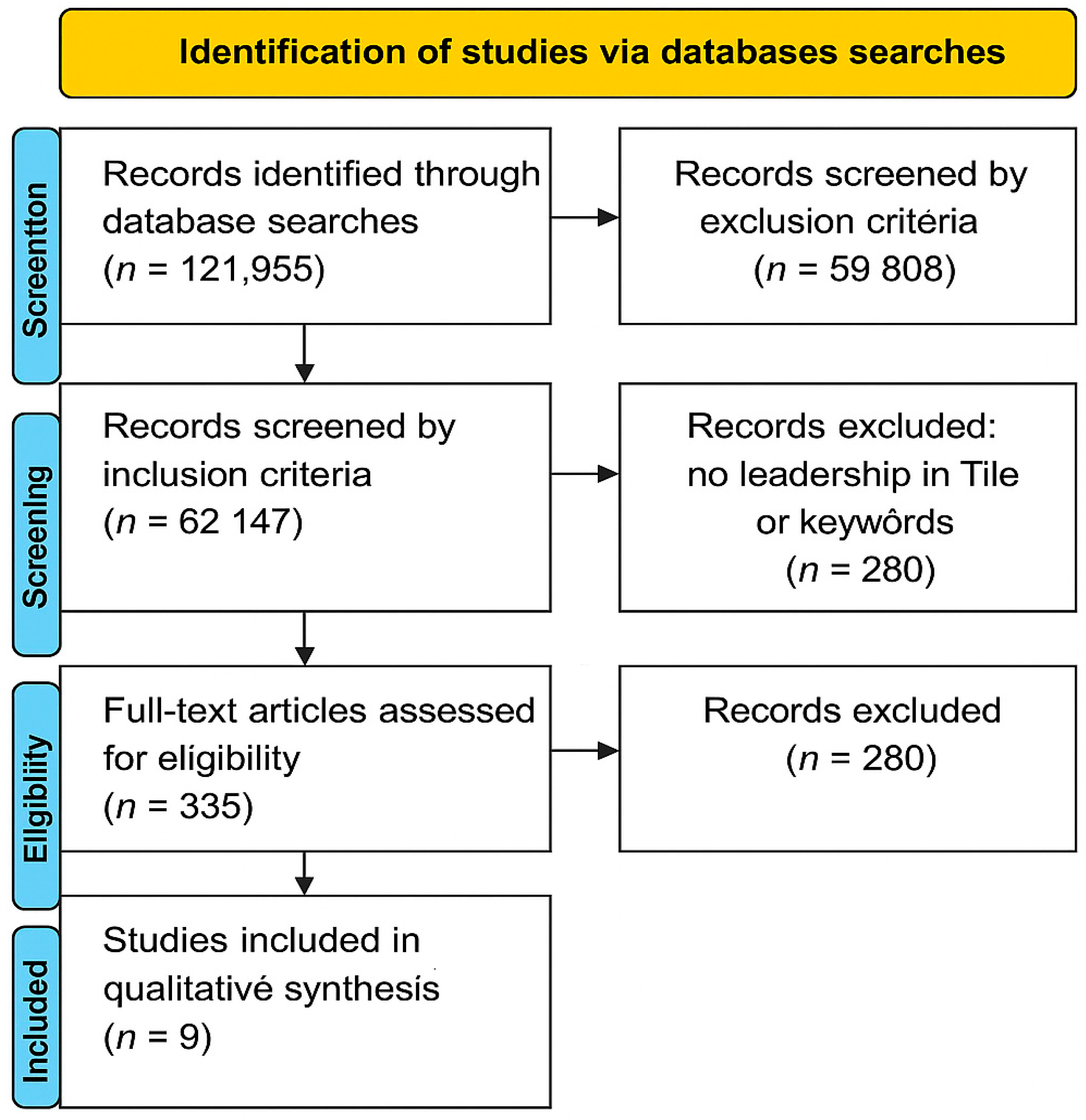

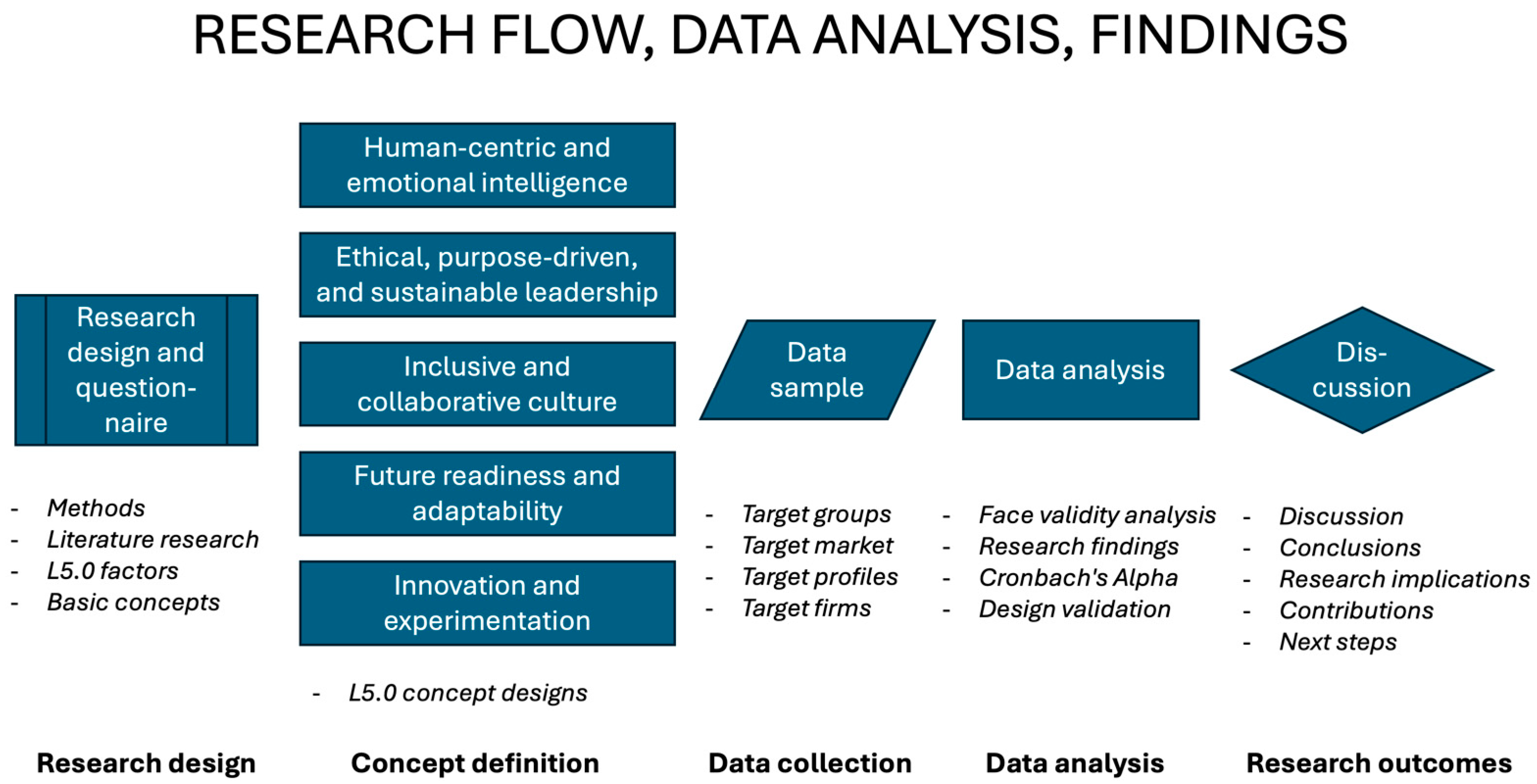
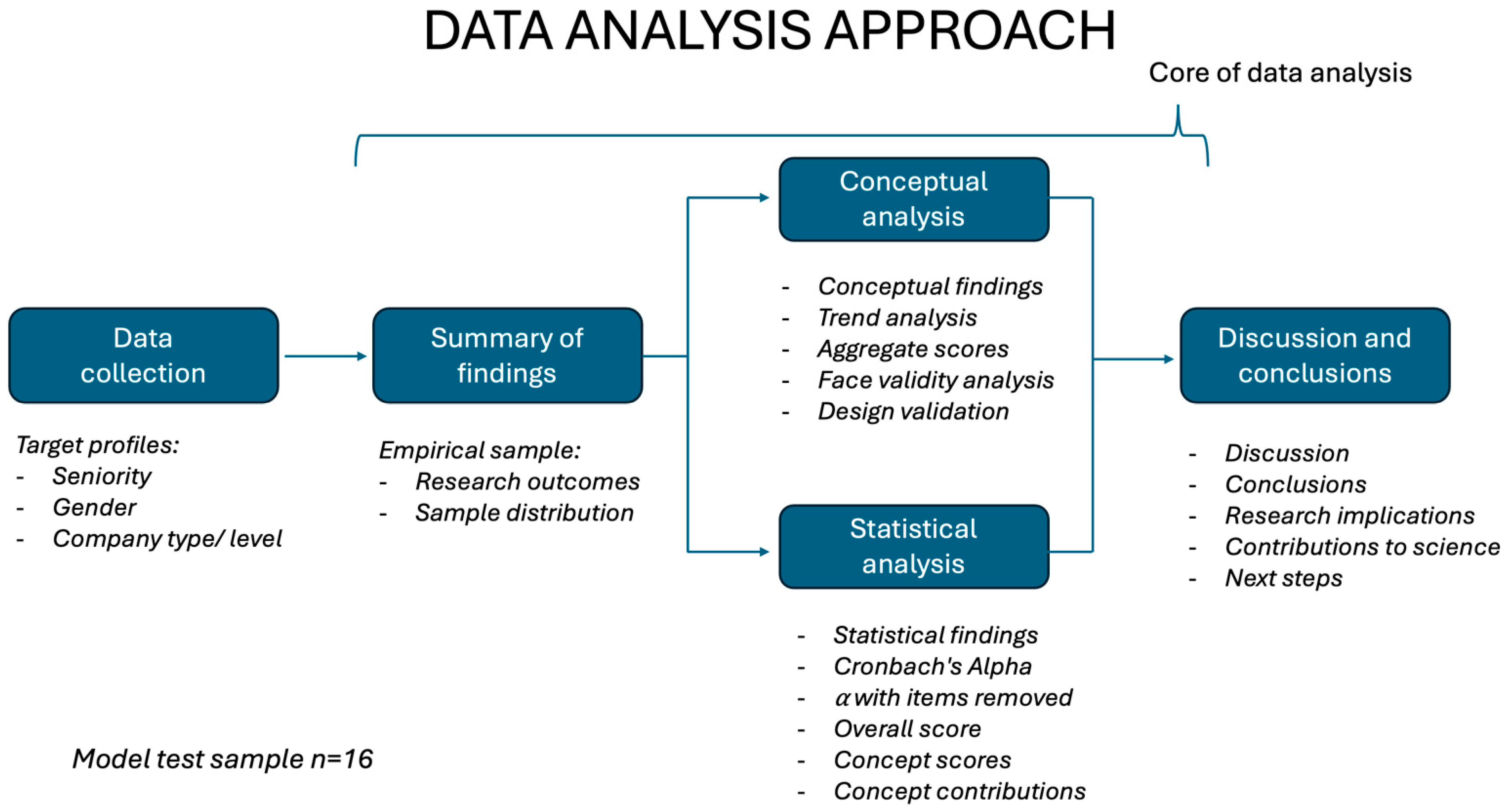




| Type of Leader | Characteristics | References |
|---|---|---|
| Servant leadership | Listening, emphasizing the needs of the team, empathy, healing, awareness, persuasion, conceptualization, foresight, stewardship, growth, community building. | Murari and Gupta (2012) Spears (2010) Van Dierendonck (2011) |
| Transformational leadership | Clear vision, empowering followers, inspire personal progress in others, promoting common goals, demonstrating behaviors that expect high performance from followers, offering support and encouraging creativity. | Podsakoff et al. (1990) Basham (2012) |
| Digital leadership/e-leadership | Advanced collaborative style, integrating Industry 5.0, drives digital transformation, aligns technology with human values. Lead in digital workplaces, blending automation with creativity and craftsmanship. Show transformative vision, good business and digital skills. | Weill and Ross (2009) Weill and Woerner (2018) Avolio and Kahai (2003) |
| Article Title | Key Insights | References |
|---|---|---|
| Strategic Leadership 5.0: Reality or Illusion? | This study initiates an exploration into strategic leadership within the context of the emerging Industry 5.0 (I5.0) era, integrating strategic leadership theory with the principles of Industry 5.0. Highlights ethical, purpose-driven, sustainable leadership, flatter hierarchies, cross-functionality, and strategic innovation. | Whitehead et al. (2025). Strategic Leadership 5.0: Reality or Illusion? Journal of the Knowledge Economy, 1–29. |
| Leadership 5.0: An Agile Mindset for a Digital Future | Highlights agility, inclusiveness, collaboration, and ethical purpose as three pillars within Leadership 5.0, emphasizing leadership as a driver of digital transformation beyond technology. Highlights purpose-driven strategy, resilience building, continuous learning and systems thinking. | Salvetti and Bertagni (2020). Leadership 5.0: an agile mindset for a digital future. International Journal of Advanced Corporate Learning, 13(2), 57. |
| Leadership 5.0. A New Approach in Higher Education | Focuses on defining challenges and proposing new leadership training methods for future engineers in higher education, emphasizing human-centric and adaptable leadership skills for complex, digital environments. Highlights human–technology balance, employee empowerment, future readiness, and purpose-driven leadership. | Serrano and Mosquera-Bolaños (2022). Leadership 5.0. a new approach in higher education. IEEE Revista Iberoamericana de Tecnologias del Aprendizaje, 17(4), 393–400. |
| Higher Education Leadership and Curricular Design in Industry 5.0 Environment | Examines the role of higher education institutions in preparing leaders for Industry 5.0, focusing on a curricular redesign that integrates sustainability, human-centric approaches, and digital literacy. Future readiness, continuous learning. | Bakir and Dahlan (2023). Higher education leadership and curricular design in Industry 5.0 environment: a cursory glance. Development and Learning in Organizations: An International Journal, 37(3), 15–17. |
| The Impact of Leadership Behaviors on Organizational Innovative Performance and Learning in AI-Driven Industry 5.0 Environments | Explores how leadership behaviors foster organizational innovation and learning in AI-driven Industry 5.0 environments, highlighting the constructive interaction between artificial intelligence and human expertise, well-being and employee empowerment, and also human—technology balance. | Alshaibani et al. (2025). The impact of leadership behaviors on organizational innovative performance and learning in AI-driven Industry 5.0 environments. Development and Learning in Organizations: An International Journal, 39(3), 18–21. |
| Intellectual Capital in Society 5.0 by the Lens of the Knowledge Creation Theory | Reviews the development of the knowledge creation theory in the context of Society 5.0, emphasizing the roles of intellectual capital, innovation, and human creativity and leadership in building sustainable, knowledge-based societies. Highlights creative problem solving, systems thinking and resilience building for long-term impact. | Konno and Schillaci (2021). Intellectual capital in Society 5.0 by the lens of the knowledge creation theory. Journal of Intellectual Capital, 22(3), 478–505. |
| Technological Innovation and Building a ‘Super Smart’ Society: Japan’s Vision of Society 5.0 | Explores Japan’s Society 5.0 vision, which combines technological innovation with sustainability to address economic and social challenges, aligning with Leadership 5.0’s emphasis on ethical and human-centric leadership. Highlights diversity and equity and human–technology balance for psychological well-being for a sustainable society. | Holroyd (2022). Technological innovation and building a ‘super smart’ society: Japan’s vision of society 5.0. Journal of Asian Public Policy, 15(1), 18–31. |
| Trust in Artificial Intelligence and the 5.0 leadership | Explores how technology leaders look to the fifth industrial revolution and the synergy between artificial intelligence, autonomous machines, and humans. When discussing the subject of leadership of the new generation 5.0, and the issue of leadership competences, trust building is critical. Issues discussed include psychological safety to develop trust, ethics, resilience building when trust is low, and long-term impact. | Balcerzyk and Czainska (2024). Trust in Artificial Intelligence and the 5.0 leadership. In Digital Synergy (pp. 94–100). CRC Press. |
| Industry 5.0–past, present, and near future. | Defines Industry 5.0 as a humanized vision of technological transformations in industry, balancing the current and future needs of the workers and society with the sustainable optimization of energy consumption, materials processing, and product lifecycles. It presents a tertiary study of literature reviews on Industry 5.0, supported by a bibliometric analysis. Highlights key themes such as agility and flexibility, human–technology balance, future readiness, continuous learning, creative problem solving, stakeholders, and collaborative leadership. | Barata and Kayser (2023). Industry 5.0–past, present, and near future. Procedia Computer Science, 219, 778–788. |
Disclaimer/Publisher’s Note: The statements, opinions and data contained in all publications are solely those of the individual author(s) and contributor(s) and not of MDPI and/or the editor(s). MDPI and/or the editor(s) disclaim responsibility for any injury to people or property resulting from any ideas, methods, instructions or products referred to in the content. |
© 2025 by the authors. Licensee MDPI, Basel, Switzerland. This article is an open access article distributed under the terms and conditions of the Creative Commons Attribution (CC BY) license (https://creativecommons.org/licenses/by/4.0/).
Share and Cite
Warner-Søderholm, G.; Kuoppamäki, M. Beyond Industry 5.0: Leadership 5.0—Driving Future-Ready Organizations. Businesses 2025, 5, 56. https://doi.org/10.3390/businesses5040056
Warner-Søderholm G, Kuoppamäki M. Beyond Industry 5.0: Leadership 5.0—Driving Future-Ready Organizations. Businesses. 2025; 5(4):56. https://doi.org/10.3390/businesses5040056
Chicago/Turabian StyleWarner-Søderholm, Gillian, and Miika Kuoppamäki. 2025. "Beyond Industry 5.0: Leadership 5.0—Driving Future-Ready Organizations" Businesses 5, no. 4: 56. https://doi.org/10.3390/businesses5040056
APA StyleWarner-Søderholm, G., & Kuoppamäki, M. (2025). Beyond Industry 5.0: Leadership 5.0—Driving Future-Ready Organizations. Businesses, 5(4), 56. https://doi.org/10.3390/businesses5040056






